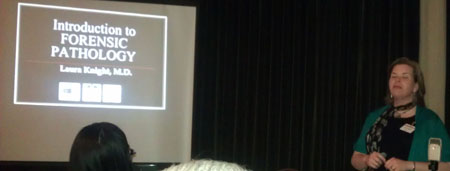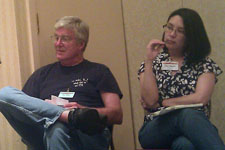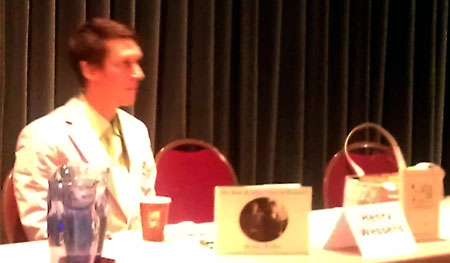Slept in a bit late on Friday. Well didn’t sleep well — never do the first night in a new place. Got up and ready to go. Registration opened at 10:00 AM. There was a program item we wanted to see at 11 so we made sure to get down to registration on time. The line was already quite lengthy. I got my registration material in the green room but my husband had to go through the pre-reg line. That’s when we hit the first snag. His registration wasn’t there so back in line for the at-the-door and filling out the forms. Finally completed the process at ll:32 AM.
If you’ve been here before you know that registration is down a side hallway. It was crowded and hot, very hot. Many of the people leaving were joking about forming a registration survivors support group. It was truly amazing that people didn’t spontaneously combust from either heat or bad tempers, especially those working at registrations who didn’t get to leave that heat for much longer than those getting registrations. That doesn’t even take into considerations the problems with some of the technical equipment. GOOD JOB in a bad environment, people.
The first panel we managed to get to was at noon.
Noon: Muzzling the Horse’s Mouth.
Panelists: Graham Sleight, Veronica Schanoes (leader), David G. Hartwell, Michael Dirda, Ruth Sternglantz.
Description: Conventions, zines, blogs, Twitter, and Facebook provide many venues for writers to shape the dialogue around their works. When it’s hard to avoid information about what a writer intended, how does that affect the critical reading experience? As readers and as critics, can we feel confident that we would have seen on our own what the writer has revealed to us? How do we differentiate and prioritize between our own insights and those shared by the author? Does the writer’s emphasis on some aspects of a work make it harder to see other aspects? And what happens when the critic’s desire to convey information about a work—such as an author’s stated intentions—comes into conflict with the critic’s desire to demonstrate a viable personal reading of the text?
What that description all boils down to is: does an author’s published intent about his work effect the critical reader? Many felt that the text should speak for itself and if the author’s intent doesn’t get borne out by the text than the readers interpretation is just as valid as the author’s.
The topic did move onto the difference between reviews and criticisms. Reviews are for people who haven’t read the book and criticisms are for those who have read the book. It was felt that all reviews are subjective views for the reviewer. Panel members felt that the best reviewers present a sincere response to the work. Readers get to know a reviewer’s taste and can then learn to trust the reviewer to either be close to their own taste or opposite to their taste. (Personally, I had one reviewer that I knew if that person hated the work then there was a good chance I’d enjoy it.)
Panel talked about how many times what you get out of the text is sufficient to enjoy the work. However, with some books a second reading can add richness and texture to your experience. (This was mostly said in relationship to the works of Gene Wolfe.)
Another interesting side issue was on audio books. There was the feeling that audio books add a paratext as the narrator (not author) reads the book using pacing, inflections, and other performance tricks that may change the experience for the listener to be different from that of a reader. [In a panel on Saturday, a blind woman talking about text-to-speech readers said she preferred the mechanical reader rather than a person because it allowed her to get an experience more like reading — when she was sighted.) Ruth Sternglantz said (and I’m paraphrasing) that audio books are not reading text but a reading of the text.
1:00 PM: Theological Debate in Fantasy and SF.
Panel: John Benson, Ellen Asher, James Morrow, Sonya Taafte, Harold Tonger Vedeler.
Description: From Spenser and Bunyan to Michael Chabon and Stephenie Meyer, writers of speculative fiction have engaged in fine-grained, subtextual theological positioning and debate. Leaving aside instances of more obvious religious maneuvering, what happens when implicit or encoded theological dialogues become invisible to readers, either because the passage of time has stripped away their contexts (as with, say, High Church vs. Low Church Anglicanism in Victorian fiction), or because they are only available to the initiated (as with Meyer’s LDS-inflected fantasy)? Are these vanishings a loss? Is there something insidious about books whose surface narratives conceal debates to which we lack access, or do these dimensions enrich the texts? Are we ‘better’ readers if we try to suss them out?
Religion for the purposes of this panel was defined as “God is in the details.”
Reader may get the moral message from a work but not the actual religious underpinnings. Panel and audience talked about specific books such as reading The Lion, The Witch, and the Wardrobe as a young person and understanding the right/wrong, good/evil, strength of family unit, etc. but totally missed the Christian message. One person said they actually thought it was a Mithras tale.
The writer doesn’t necessarily add religious underpinning but the religion is so much a part of the writer’s world view and core beliefs that it is intrinsic to how he or she see and interacts with the world and thus it shows in the text.
There was also a lively discussion of whether it even mattered if you didn’t recognize the religious underpinnings. Was the reader’s enjoyment any less valid if they didn’t get it? Most thought that it didn’t really matter if they recognized which religion if they got the basic moral message being conveyed.
One comment that I found interesting was that mysticism is flexible and theology is not. I hadn’t really thought of it in this way before but did see it as being more or less a valid way of looking at things.

2:00 PM: Serendipity in the Digital Age.
Panel: David G. Shaw (L), John Benson, John Clute, Michael J. DeLuca, Kathryn Morrow, Michael Dirda.
Description: Libraries are closing off their stacks from patrons and sending robots to retrieve requested books; brick-and-mortar bookstores are being supplanted by Amazon’s massive warehouses and recommendation engines. While these arrangements increase efficiency on the business end, they destroy serendipity on the reader’s end. Yet sites like Wikipedia and TV Tropes give us what Randall Munroe called “hours of fascinated clicking,” trails of discovery that strongly resemble the old-fashioned bookstore or library experience. Can those sites teach us how to recreate browsing in our browsers? Should Amazon look more like the new online edition of the Science Fiction Encyclopedia?
We all love to browse in bookstores and library stacks. However, more and more libraries have closed stacks and many bookstores are closing or there are none near you and you end up with online sites that have recommendation engines which are often not really your taste or not finding things by chance.
On the other hand the panel agreed in principle that we’ve never really had true serendipity since bookstores and libraries don’t have everything but only what the buyers believe the patrons will want. There’s always been a limiting factor on what we can browse and that hasn’t changed. So, we need to try harder to find that gem that wouldn’t normally be the kind of thing you read but that you stumble across anyway.

3:00 PM: Anthropology for Writers.
Panel: James L. Cambias, John H. Stevens (L), Christopher M. Cevasco, Francesca Forrest, Harold Torger Vedeler.
Description: In a 2011 blog post, Farah Mendlesohn wrote, “‘Worldbuilding’ as we understand it, has its roots in traditions that described the world in monolithic ways: folklore studies, anthropology, archeology, all began with an interest in describing discrete groups of people and for that they needed people to be discrete.” This panel will discuss the historical and present-day merging and mingling of real-world cultures, and advise writers on building less monolithic and more plausible fictional ones.
The conversation among the panelists was interesting and wide ranging but the key to this panel was summed up at the very beginning by Harold Torger Vedeler in three points:
- Worlds must change over time allowing the characters to act in a historical context.
- No world is homogenous. Story may look at only one group but the other societies will have an impact on that one.
- People often say one thing and do another. They may idealize their culture but then what they actually do doesn’t agree with that idealized culture.

4:00 PM: Sherlock Holmes, Now and Forever.
Panel: Veronica Schanoes, Ellen Asher, Michael Dirda, Victoria Janssen, Fred Lerner.
Description: Sherlock Holmes is everywhere right now: in TV series like House, BBC’s Sherlock, and the upcoming Elementary; in the Robert Downey Jr. movies; and in books and stories being written about Holmes and his creator, Sir Arthur Conan Doyle. What accounts for the endless appeal of this character? Are we ever going to get tired of brilliant and slightly mad detectives? Or is it all really about Watson, as suggested by our collective urge to keep telling and retelling Holmes’s stories?
Lively and interesting points were made by the panelist and the audience. The key element, it was agreed, to remember is that there is a distinction between the stories by Conan Doyle and the interpretation of the stories in movies and in other media and the continuation or addition of new material by others writing about Holmes and Watson.
Key reasons why the stories are still popular was thought to be the atmosphere of the stories and the friendship of the two main characters.
Evening: We decided to call it a day. Went out for dinner and found Brave was showing so went to see it more on that later.
That’s it for Friday. I hope to have my Saturday of Readercon report up soon.







 Yesterday after a long day at work, I stopped by the post office to mail out the latest batch of books. Shortly after getting into line, a woman came in and asked if anybody liked cats, because there as a kitten outside that looked like it was in some distress. What she got was a lot of folks ignoring her, or telling her that they were dog folks, or allergic, or one of a dozen other excuses. I too was reluctant to speak up, because while Gayle’s allergies are being kept under control as long as we use the Allerpet on Emnot, there’s no guarantee that it would be effective on a different cat. Nor was there any guarantee that Emnot would tolerate another cat in the house. He has a tendency to go all territorial warlord whenever another cat dares to come up on the porch. Of course, that display is limited to when the door is closed, or when one of his human’s goes out to back him up.
Yesterday after a long day at work, I stopped by the post office to mail out the latest batch of books. Shortly after getting into line, a woman came in and asked if anybody liked cats, because there as a kitten outside that looked like it was in some distress. What she got was a lot of folks ignoring her, or telling her that they were dog folks, or allergic, or one of a dozen other excuses. I too was reluctant to speak up, because while Gayle’s allergies are being kept under control as long as we use the Allerpet on Emnot, there’s no guarantee that it would be effective on a different cat. Nor was there any guarantee that Emnot would tolerate another cat in the house. He has a tendency to go all territorial warlord whenever another cat dares to come up on the porch. Of course, that display is limited to when the door is closed, or when one of his human’s goes out to back him up.







